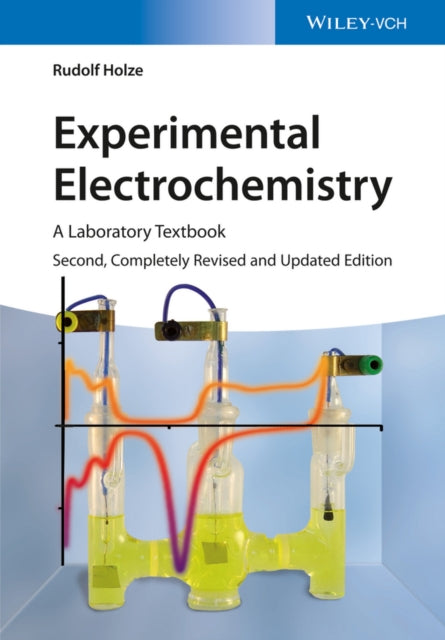Rudolf Holze
Experimental Electrochemistry: A Laboratory Textbook
Experimental Electrochemistry: A Laboratory Textbook
YOU SAVE £9.06
- Condition: Brand new
- UK Delivery times: Usually arrives within 2 - 3 working days
- UK Shipping: Fee starts at £2.39. Subject to product weight & dimension
Bulk ordering. Want 15 or more copies? Get a personalised quote and bigger discounts. Learn more about bulk orders.
Couldn't load pickup availability
- More about Experimental Electrochemistry: A Laboratory Textbook
A new edition of a textbook on electrochemical experiments has been released, providing clear and easy-to-follow instructions for carrying out experiments, illustrating important principles and applications, and highlighting potential dangers and risks.
\n Format: Paperback / softback
\n Length: 288 pages
\n Publication date: 09 October 2019
\n Publisher: Wiley-VCH Verlag GmbH
\n
Maintaining its didactic approach, this successful textbook provides clear and easy-to-follow instructions for carrying out the experiments, illustrating the most important principles and applications in modern electrochemistry, while pointing out the potential dangers and risks involved. This second edition contains 84 experiments, many of which cover electrochemical energy conversion and storage as well as electrochemical equilibrium.
Introduction:
Electrochemistry is a fundamental science that plays a crucial role in various fields, including energy production, materials science, and environmental science. It involves the study of the interactions between electrons and ions in chemical reactions, and the conversion of chemical energy into electrical energy.
Experimental Methods:
Experiments are an essential part of electrochemistry, as they allow scientists to observe and understand the behavior of electrochemical systems. There are several experimental methods used in electrochemistry, including potentiometry, voltammetry, electrochemical impedance spectroscopy (EIS), and electrochemical scanning electron microscopy (ESEM).
Potentiometry:
Potentiometry is a method used to measure the potential difference between two electrodes in an electrochemical cell. It involves the use of a voltmeter to measure the voltage between the electrodes, and a reference electrode to establish the potential reference point.
Voltammetry:
Voltammetry is a method used to measure the current flowing through an electrochemical cell. It involves the use of a voltmeter to measure the potential difference between the electrodes, and a chronoamperometer to measure the current.
Electrochemical Impedance Spectroscopy:
Electrochemical impedance spectroscopy (EIS) is a method used to study the electrical properties of electrochemical systems. It involves the measurement of the impedance of the system at different frequencies and potentials.
Electrochemical Scanning Electron Microscopy:
Electrochemical scanning electron microscopy (ESEM) is a method used to study the surface properties of electrochemical systems. It involves the use of a scanning electron microscope to image the surface of the system at high resolution.
Experimental Setup:
The experimental setup for electrochemical experiments can vary depending on the type of experiment being carried out. However, a typical setup includes an electrochemical cell, electrodes, a voltmeter, a chronoamperometer, and a reference electrode.
Experimental Results:
The experimental results obtained from electrochemical experiments can provide valuable insights into the behavior of electrochemical systems. These results can be used to validate theoretical models, develop new electrochemical technologies, and understand the underlying mechanisms of chemical reactions.
Applications:
Electrochemistry has numerous applications in various fields, including energy production, materials science, and environmental science. For example, electrochemical batteries are used to store and convert electrical energy, while electrochemical sensors are used to detect and measure various chemicals and parameters in the environment.
Conclusion:
Electrochemistry is a fascinating and complex science that plays a crucial role in various fields. By understanding the theoretical principles and experimental methods used in electrochemistry, scientists can develop new technologies and solutions to address real-world problems.
\n Weight: 532g\n
Dimension: 244 x 170 x 14 (mm)\n
ISBN-13: 9783527335244\n
Edition number: 2nd Edition\n
This item can be found in:
UK and International shipping information
UK and International shipping information
UK Delivery and returns information:
- Delivery within 2 - 3 days when ordering in the UK.
- Shipping fee for UK customers from £2.39. Fully tracked shipping service available.
- Returns policy: Return within 30 days of receipt for full refund.
International deliveries:
Shulph Ink now ships to Australia, Belgium, Canada, France, Germany, Ireland, Italy, India, Luxembourg Saudi Arabia, Singapore, Spain, Netherlands, New Zealand, United Arab Emirates, United States of America.
- Delivery times: within 5 - 10 days for international orders.
- Shipping fee: charges vary for overseas orders. Only tracked services are available for most international orders. Some countries have untracked shipping options.
- Customs charges: If ordering to addresses outside the United Kingdom, you may or may not incur additional customs and duties fees during local delivery.


